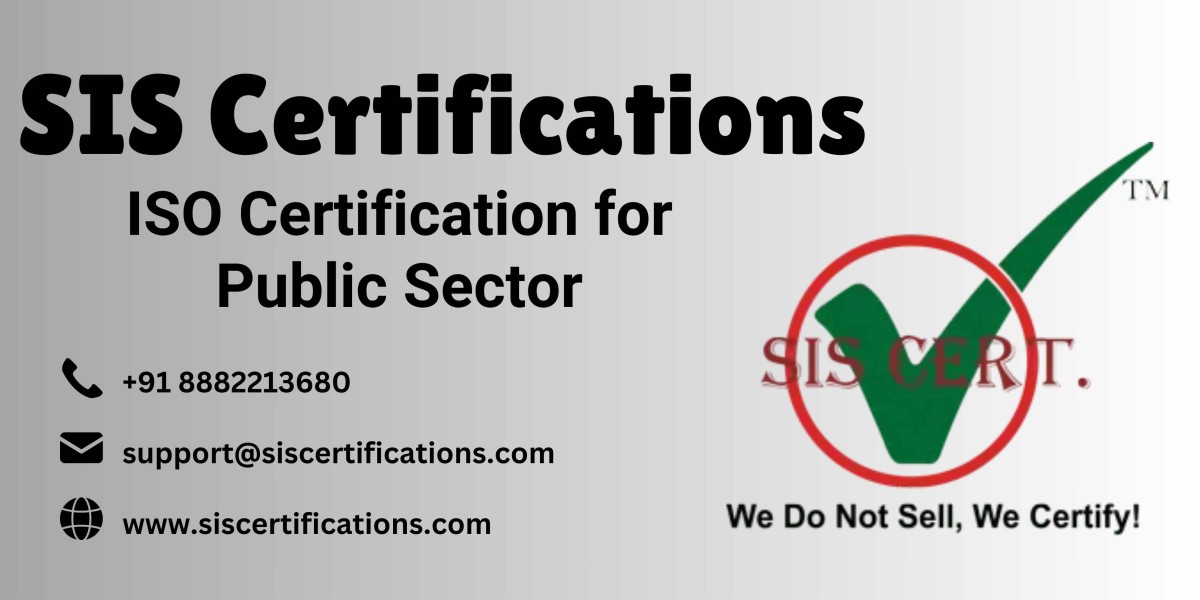How ISO Certification is Helpful for the Public Sector?
ISO certification provides a structured framework for public sector organizations to improve their processes, deliver consistent services, and meet stakeholder expectations. By adopting internationally recognized standards, public sector entities can align their operations with global best practices, fostering transparency and accountability.
Enhanced Service Delivery: ISO standards, such as ISO 9001, focus on quality management, ensuring that public sector services meet citizen needs efficiently. This leads to streamlined processes, reduced errors, and faster response times.
Increased Public Trust: Certification signals a commitment to quality and accountability, reassuring citizens that public services adhere to high standards. This is particularly crucial for government bodies handling sensitive areas like healthcare, education, or public safety.
Operational Efficiency: ISO standards encourage process optimization, reducing waste and improving resource utilization. For public sector organizations, this translates to cost savings and better allocation of taxpayer funds.
Global Recognition: ISO certification aligns public sector entities with international benchmarks, facilitating collaboration with global partners and enhancing credibility in international forums.
Compliance and Risk Management: Standards like ISO 27001 (Information Security) and ISO 14001 (Environmental Management) help public sector organizations mitigate risks, protect sensitive data, and ensure compliance with regulatory requirements.
By adopting ISO Certification for Public Sector, government bodies can transform their operations, making them more citizen-centric and sustainable.
ISO Certification Process for Public Sector
Achieving ISO Certification for Public Sector involves a systematic process tailored to the unique needs of government organizations. Below is a step-by-step guide to the certification process:
Gap Analysis: The first step is conducting a gap analysis to assess current processes against the requirements of the desired ISO standard. This identifies areas for improvement and helps create a roadmap for certification.
Planning and Documentation: Develop a detailed plan outlining the steps to achieve compliance. This includes documenting processes, policies, and procedures to align with ISO standards. For instance, ISO 9001 requires a quality management system (QMS) with documented procedures.
Implementation: Train employees and implement the documented processes across the organization. This may involve restructuring workflows, adopting new technologies, or enhancing data security measures, depending on the standard.
Internal Audit: Conduct an internal audit to evaluate the effectiveness of the implemented system. This helps identify any non-conformities and areas needing corrective action.
Management Review: Senior management reviews the audit findings to ensure the system aligns with organizational goals and ISO requirements.
Certification Audit: Engage an accredited certification body to perform an external audit. This typically occurs in two stages:
Stage 1: A documentation review to verify readiness.
Stage 2: An in-depth audit of processes and their implementation.
Certification and Maintenance: Upon successful completion of the audit, the organization receives the ISO certificate. To maintain certification, regular surveillance audits are conducted, typically annually, with a recertification audit every three years.
The process for ISO Certification for Public Sector requires commitment from leadership and staff, but the resulting improvements in efficiency and credibility make it worthwhile.
Which Standards or ISO Certificates Are Required for the Public Sector?
The public sector encompasses diverse functions, from healthcare to transportation, and different ISO standards apply based on specific needs. Below are some key ISO standards relevant to ISO Certification for Public Sector:
ISO 9001: Quality Management System: This is the most widely adopted standard, focusing on consistent quality in service delivery. It’s ideal for public sector entities aiming to enhance citizen satisfaction and operational efficiency.
ISO 27001: Information Security Management: Critical for government bodies handling sensitive data, this standard ensures robust cybersecurity measures to protect citizen information.
ISO 14001: Environmental Management System: Public sector organizations, especially those managing infrastructure or utilities, use this standard to minimize environmental impact and promote sustainability.
ISO 45001: Occupational Health and Safety: This standard ensures safe working conditions for public sector employees, particularly in high-risk areas like public works or emergency services.
ISO 37001: Anti-Bribery Management System: Particularly relevant for public sector entities, this standard helps prevent corruption and promotes ethical governance.
ISO 22301: Business Continuity Management: This standard ensures public sector organizations can continue operations during disruptions, such as natural disasters or cyberattacks.
Choosing the right standard depends on the organization’s goals, operational scope, and stakeholder expectations. Many public sector entities pursue multiple certifications to address various aspects of their operations.
Benefits of ISO Certification for Public Sector
The advantages of ISO Certification for Public Sector extend beyond compliance, delivering tangible and intangible benefits:
Improved Accountability: Certification ensures transparent processes, making it easier to track performance and address citizen grievances.
Cost Savings: By optimizing processes and reducing inefficiencies, public sector organizations can save costs, ensuring better use of public funds.
Enhanced Reputation: ISO certification enhances the organization’s reputation, fostering trust among citizens, stakeholders, and international partners.
Employee Engagement: Standardized processes and clear guidelines improve employee morale and productivity, as staff understand their roles in achieving organizational goals.
Regulatory Compliance: ISO standards align with many regulatory requirements, reducing the risk of legal or compliance issues.
Sustainability: Standards like ISO 14001 promote environmentally responsible practices, aligning with global sustainability goals.
Competitive Advantage: Certified public sector entities stand out in international collaborations, attracting funding and partnerships.
These benefits collectively contribute to more effective governance and higher public satisfaction, making ISO Certification for Public Sector a valuable investment.
ISO Certification Process for Automotive Industry
While this blog focuses on ISO Certification for Public Sector, it’s worth exploring how ISO certification applies to other industries, such as automotive, to highlight its versatility. The automotive industry, like the public sector, relies on ISO standards to ensure quality, safety, and efficiency. The certification process for the automotive industry follows a similar framework but includes industry-specific standards.
Gap Analysis: Assess current processes against standards like IATF 16949, which is specific to automotive quality management.
System Development: Develop a quality management system tailored to automotive requirements, focusing on defect prevention, supply chain management, and continuous improvement.
Training and Implementation: Train staff on automotive-specific standards and implement processes across manufacturing, supply chain, and quality control.
Internal Audits: Conduct audits to ensure compliance with IATF 16949 or other relevant standards like ISO 14001 for environmental management.
Certification Audit: Engage a certification body to perform a two-stage audit, similar to the public sector process.
Continuous Improvement: Maintain certification through regular audits and ongoing process enhancements.
The automotive industry often pursues IATF 16949, which builds on ISO 9001 but includes additional requirements for automotive production, such as risk management and supplier quality assurance. This comparison underscores the adaptability of ISO standards across sectors, including ISO Certification for Public Sector.
FAQs
Q1: What is ISO Certification for Public Sector?
ISO Certification for Public Sector refers to the process of achieving compliance with international standards set by the International Organization for Standardization (ISO). These standards ensure quality, efficiency, and reliability in public sector operations.
Q2: How long does it take to achieve ISO certification?
The timeline varies depending on the organization’s size and readiness. Typically, it takes 6-12 months, including gap analysis, implementation, and audits.
Q3: Is ISO certification mandatory for public sector organizations?
No, ISO certification is voluntary. However, it is increasingly adopted to enhance credibility and meet stakeholder expectations.
Q4: Can small public sector entities pursue ISO certification?
Yes, ISO standards are scalable and can be tailored to organizations of any size, including small government bodies.
Q5: How often are audits required to maintain certification?
Surveillance audits are conducted annually, with a recertification audit every three years.
Conclusion
ISO Certification for Public Sector is a powerful tool for enhancing operational efficiency, building public trust, and aligning with global standards. By adopting standards like ISO 9001, ISO 27001, or ISO 14001, public sector organizations can deliver high-quality services, optimize resources, and promote sustainability. The certification process, while rigorous, offers long-term benefits that outweigh the initial investment. Whether in the public sector or industries like automotive, ISO certification remains a universal benchmark for excellence. By pursuing ISO Certification for Public Sector, government entities can set a precedent for quality and accountability, ultimately serving citizens better.






